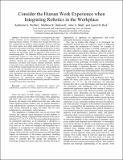| dc.contributor.author | Welfare, Katherine S. | |
| dc.contributor.author | Hallowell, Matthew R. | |
| dc.contributor.author | Shah, Julie A | |
| dc.contributor.author | Riek, Laurel D. | |
| dc.date.accessioned | 2020-06-19T20:56:38Z | |
| dc.date.available | 2020-06-19T20:56:38Z | |
| dc.date.issued | 2019 | |
| dc.identifier.isbn | 978-1-5386-8555-6 | |
| dc.identifier.issn | 2167-2148 | |
| dc.identifier.uri | https://hdl.handle.net/1721.1/125902 | |
| dc.description.abstract | Worldwide, manufacturers are reimagining the future of their workforce and its connection to technology. Rather than replacing humans, Industry 5.0 explores how humans and robots can best complement one another's unique strengths. However, realizing this vision requires an in-depth understanding of how workers view the positive and negative attributes of their jobs, and the place of robots within it. In this paper, we explore the relationship between work attributes and automation goals by engaging in field research at a manufacturing plant. We conducted 50 face-to-face interviews with assembly-line workers (n=50), which we analyzed using discourse analysis and social constructivist methods. We found that the work attributes deemed most positive by participants include social interaction, movement and exercise, (human) autonomy, problem solving, task variety, and building with their hands. The main negative work attributes included health and safety issues, feeling rushed, and repetitive work. We identified several ways robots could help reduce negative work attributes and enhance positive ones, such as reducing work interruptions and cultivating physical and psychological well-being. Based on our findings, we created a set of integration considerations for organizations planning to deploy robotics technology, and discuss how the manufacturing and HRI communities can explore these ideas in the future. | en_US |
| dc.description.sponsorship | National Science Foundation (grant no. IIP-1724982) | en_US |
| dc.language.iso | en | |
| dc.publisher | IEEE | en_US |
| dc.relation.isversionof | 10.1109/HRI.2019.8673139 | en_US |
| dc.rights | Creative Commons Attribution-Noncommercial-Share Alike | en_US |
| dc.rights.uri | http://creativecommons.org/licenses/by-nc-sa/4.0/ | en_US |
| dc.source | other univ website | en_US |
| dc.title | Consider the human work experience when integrating robotics in the workplace | en_US |
| dc.type | Article | en_US |
| dc.identifier.citation | Welfare, Katherine S., et al., "Consider the human work experience when integrating robotics in the workplace." HRI '19: 14th ACM/IEEE International Conference on Human-Robot Interaction, Mar. 11-14, 2019, Daegu, South Korea, IEEE, 2019: p. 75-84 doi 10.1109/HRI.2019.8673139 ©2019 Author(s) | en_US |
| dc.contributor.department | Massachusetts Institute of Technology. Computer Science and Artificial Intelligence Laboratory | en_US |
| dc.relation.journal | ACM/IEEE International Conference on Human-Robot Interaction | en_US |
| dc.eprint.version | Author's final manuscript | en_US |
| dc.type.uri | http://purl.org/eprint/type/ConferencePaper | en_US |
| eprint.status | http://purl.org/eprint/status/NonPeerReviewed | en_US |
| dc.date.updated | 2019-11-01T13:01:44Z | |
| dspace.date.submission | 2019-11-01T13:01:51Z | |
| mit.journal.volume | 14th | en_US |
| mit.metadata.status | Complete | |
